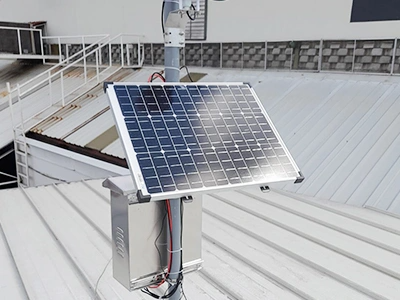Weather plays a vital role in our lives. It influences our comfort, gardening, energy use, and safety. Rooftop weather stations are becoming popular in smart cities. They help monitor real-time weather conditions for homes and businesses.
Rooftop systems have advantages over ground-mounted ones. They reduce interference and offer a clear view of the sky. This setup allows for accurate measurements of key weather variables.
A rooftop weather station provides reliable local weather data. This is valuable for homeowners, office managers, or industrial sites.
This article will explain how rooftop weather stations work. It will highlight their main features and benefits. These stations are useful for weather monitoring, energy management, agriculture, and urban planning.

A rooftop weather station includes sensors. It is installed on a building's roof.
This system tracks key environmental factors.
These factors include:
Temperature
Humidity
Wind speed
Wind direction
Solar radiation
Barometric pressure
Rainfall
They often have data loggers, wireless modules, and cloud connectivity. This setup makes data access easy.
Rooftop installations work best when there are no ground obstacles. Trees and buildings can affect measurements. Elevating the station enhances data quality and visibility. This is especially true in cities with changing microclimates.
Here are the essential components of a quality rooftop weather station:
Multi-Parameter Sensors
Most rooftop stations can monitor several weather factors:
Wind Speed and Direction
Cumulative Rainfall
UV Index
Barometric Pressure
These sensors track everything from passing showers to long-term climate trends.
Accurate Measurements
Accuracy is vital, especially for HVAC optimization or climate research. Top rooftop stations use industrial-grade sensors to ensure reliable data.
Barometric Pressure Monitoring
Measuring barometric pressure is crucial for understanding weather changes. Pressure data helps with aviation safety, HVAC calibration, and indoor comfort.
Wireless Connectivity
Modern stations offer Wi-Fi, LoRa, RS485 (Modbus RTU), and NB-IoT. These features make it easy to transmit data. This is key for weather stations that must send data to central systems.
Remote Monitoring & Alerts
Users can view real-time data and receive alerts via mobile apps or web platforms. This helps facility managers, researchers, and homeowners monitor weather changes from afar.
Rooftop installations provide unique advantages for residences, commercial properties, or municipal buildings:
✅ Clear Sky Access for Better Data
High placements reduce interference from buildings and trees. This results in better local weather measurements, especially for wind and solar radiation.
✅ Enhanced Safety & Preparedness
Real-time alerts for strong winds or heavy rain help operators take action. This protects both infrastructure and people.
✅ Energy Efficiency
Data from rooftop stations helps automate HVAC systems and improve ventilation. This reduces energy waste and costs.
✅ Environmental Monitoring
These stations support sustainability goals by tracking carbon footprints and promoting urban greening.

Office Buildings & Commercial Complexes
Big buildings can save energy. They do this by changing HVAC and lighting systems. They use real-time local weather data for these adjustments. Rooftop weather stations provide the accuracy needed for indoor climate control.
Industrial Facilities
Factories and power plants check barometric pressure, wind, and temperature. They do this to adjust processes and follow regulations.
Broadcasters and research institutes use rooftop weather stations to enhance wider weather networks. They provide hyperlocal data for better predictions.
Hotels and Resorts
Hospitality businesses use weather data to manage outdoor activities and improve guest comfort.
Home Weather Station Enthusiasts
Homeowners install rooftop systems to check the weather. This information helps with gardening, heating, and storm awareness.
Some individuals are simply interested in weather patterns. These home weather stations offer real-time insights into backyard microclimates.
Greenhouses & Rooftop Gardens
Urban farmers and greenhouse operators use weather stations. These help them decide when to water and ventilate. Data on sunlight and humidity ensures better yields.
Education and Citizen Science
Rooftop weather stations are great for schools and weather fans. They can help with STEM education and personal research.
When selecting a system, consider:
Sensor Accuracy: Look for high-precision components for temperature and humidity.
Data Accessibility: Can the system allow remote viewing and send alerts?
Power Source: Choose between solar, battery-operated, or wired setups.
Installation Requirements: Ensure the system is weatherproof and easy to mount.
Integration Compatibility: Check if it supports standard protocols like Modbus RTU or MQTT.
Coda Sensor provides customizable rooftop weather stations for commercial and residential use. Our systems support real-time monitoring of:
Temperature and humidity
Solar radiation
Barometric pressure
Rainfall and more
Every unit we craft is a powerhouse of performance and resilience. Your perfect solution awaits, tailored to fit your every need. Whether for a bustling commercial space, a cozy home, or a green rooftop oasis, we have you covered.
Rooftop weather stations are the eyes in the sky for our data-driven age. They monitor barometric pressure, turning forecasts into a breeze of clarity. Collecting precise measurements, they fuel energy systems and nurture agriculture. These vital tools offer valuable insights, making efficiency their hallmark.
If you own a home or manage a property, knowing your local climate is crucial. Installing a rooftop weather station can help. It offers ongoing benefits and peace of mind.
Interested in upgrading your site with a rooftop weather monitoring system? Contact Coda Sensor today for expert advice tailored to your project.
Discover how water level sensors reduce labor co
Learn how CODA Sensor solar radiation and PAR se
Discover how real-time weather station data impr
Contact: Molly
Phone: +86-17775769236
Tel: 86-0731-85117089
Email: molly@codasensor.com
Add: Building S5, Aux Square, Yuelu District, Changsha City, Hunan Province, China
We chat